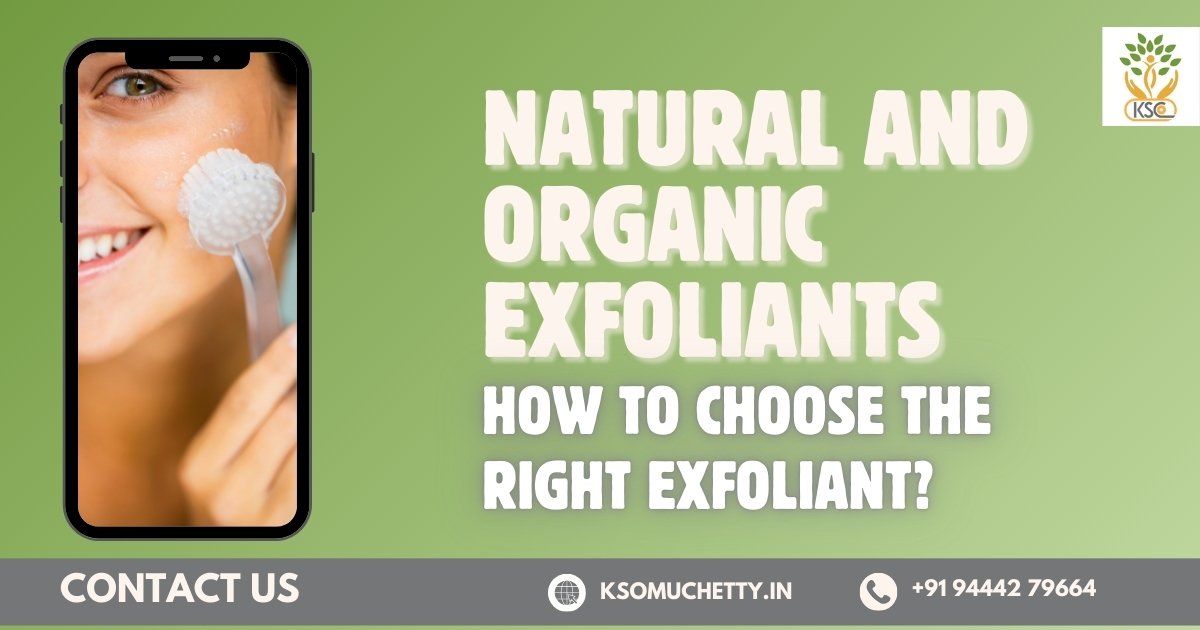Introduction
Exfoliation is an essential step in any skincare routine. It helps remove dead skin cells, unclog pores, and reveal fresh, glowing skin. This simple process improves your skin’s texture and can even out your skin tone over time. In this blog, we’ll dive into natural and organic exfoliants, which are much better for your skin and the environment than synthetic or chemical-based products. Whether you want to buy natural organic scrubbers & exfoliators or create your own at home, this guide will help you choose the right one for your needs.
1. What is Exfoliation?
Exfoliation is the process of removing dead skin cells from the surface of your skin. These dead cells can accumulate over time, leading to dull skin, clogged pores, and even breakouts. Regular exfoliation helps remove this buildup, allowing newer skin cells to surface. This results in smoother, brighter skin and can improve the absorption of moisturizers and other skincare products.
There are two primary types of exfoliation:
1. Physical Exfoliation: This involves using a scrub or tool to remove dead skin cells manually. Examples include sugar scrubs, salt scrubs, coffee grounds, and exfoliating brushes. Physical exfoliation can be more aggressive on the skin, so it’s essential to use gentle pressure and the right ingredients to avoid damaging your skin.
2. Chemical Exfoliation: This type uses acids or enzymes to dissolve dead skin cells. Popular chemical exfoliants include alpha-hydroxy acids (AHAs) like glycolic or lactic acid and beta-hydroxy acids (BHAs) like salicylic acid. Chemical exfoliation is typically gentler than physical exfoliation, as it doesn’t involve scrubbing and can be more effective in the long term for improving skin texture and tone.
2. Why Choose Natural and Organic Exfoliants?
Many store-bought exfoliants contain harsh chemicals or synthetic microbeads that can harm your skin and the environment. By choosing natural and organic exfoliants, you opt for safer products for you and the planet.
Here’s why natural exfoliants are the better choice:
- Gentle on the Skin: Natural exfoliants are made from natural ingredients, such as fruits, sugars, and oils. They are less likely to cause irritation, redness, or breakouts than chemical-laden products.
- Eco-Friendly: Natural products often come from sustainable sources, and many companies that produce them are conscious of their environmental impact. Unlike synthetic microbeads, natural exfoliants like coffee grounds or sugar do not contribute to ocean pollution.
- Nourishing: Natural exfoliants often contain vitamins, minerals, and antioxidants that nourish the skin while exfoliating. For instance, ingredients like honey or oatmeal can soothe and hydrate the skin during the exfoliation process.
3. Types of Natural Exfoliants
A wide variety of natural exfoliants can be used on the skin, each offering different benefits depending on your skin type and needs. Here are some popular natural exfoliants:
1. Physical Exfoliants
- Sugar Scrubs: Sugar is a gentle exfoliant that can be mixed with oils, like coconut or olive oil, to create a hydrating scrub. It helps remove dead skin cells while moisturizing the skin.
- Coffee Grounds: Coffee grounds are a popular exfoliant known for improving circulation and reducing puffiness. They are also packed with antioxidants that can benefit the skin.
- Oatmeal: Oatmeal is a soothing exfoliant, perfect for sensitive skin. It gently removes dead skin cells while calming inflammation and irritation.
- Sea Salt: Sea salt scrubs are more abrasive and better suited for body exfoliation than the face. They help detoxify the skin and are rich in minerals like magnesium and calcium.
2. Chemical Exfoliants
- Fruit Acids (AHAs): Natural fruit acids, such as those found in papayas, pineapples, and citrus fruits, are great for chemical exfoliation. AHAs, like glycolic acid, help dissolve the bonds between dead skin cells, allowing them to be gently sloughed away.
- Lactic Acid: Lactic acid is a gentler AHA derived from milk or fermented fruits. It’s great for people with sensitive skin and helps hydrate while exfoliating.
- Enzymes: Fruit enzymes from pineapples and papayas naturally break down dead skin cells, providing a gentle yet effective chemical exfoliation.
4. How to Choose the Right Exfoliant for Your Skin Type
Choosing the right exfoliant depends on your skin type and the issues you want to address.
- Oily Skin: You might benefit from exfoliants with salicylic acid or clay-based products if you have oily skin. These help absorb excess oil and clear out clogged pores.
- Dry Skin: Dry skin should opt for gentle, hydrating scrubs, like sugar or oatmeal-based exfoliants. Chemical exfoliants like lactic acid can also be helpful, as they exfoliate and moisturize simultaneously.
- Sensitive Skin: Sensitive skin requires extra care, so stick to enzyme-based or gentle physical exfoliants like oatmeal. Avoid harsh scrubs or acids that could irritate.
- Normal/Combination Skin: Those with normal or combination skin can use a mix of both physical and chemical exfoliants. Experiment with sugar scrubs and enzyme-based products to find what works best for your skin.
5. DIY Natural Exfoliant Recipes
Making your exfoliants at home is easy and affordable and ensures you know exactly what ingredients are on your skin. Here are some simple recipes to try:
- Sugar Scrub: Combine 1 cup of sugar with ½ cup coconut oil. Add a few drops of essential oil for fragrance if desired. Use this on your body for soft, moisturized skin.
- Coffee Scrub: Mix 1 cup of coffee grounds with ¼ cup of honey. Use this in the shower to invigorate your skin and boost circulation.
- Oatmeal Exfoliant: Blend 1 cup of oatmeal into a fine powder and mix with ½ cup of yoghurt. Apply to your face for a calming, gentle exfoliation.
- Fruit Enzyme Exfoliant: Mash a small piece of papaya or pineapple and apply it to your face. The natural enzymes in these fruits will gently dissolve dead skin cells.
6. Tips for Exfoliating Safely
While exfoliation is beneficial, it’s essential to do it safely to avoid damaging your skin:
- Frequency: Exfoliating 1-3 times a week is usually enough. Over-exfoliating can lead to irritation and make your skin more sensitive to the sun.
- Patch Test: Always perform a patch test before trying a new exfoliant, especially if you have sensitive skin.
- Moisturize After Exfoliating: Exfoliation can sometimes leave your skin feeling dry, so follow up with a good moisturizer to lock in hydration.
7. Where to Buy Natural Organic Scrubbers & Exfoliators
You can find natural and organic exfoliants in stores or online. One excellent option is K.Somu Chetty & Co., your premier source for authentic, high-quality natural products. Welcome to K.Somu Chetty & Co, where we believe in the power of nature to promote well-being. Our products are selected for their quality, purity, and effectiveness, ensuring they meet the highest standards. Whether you’re looking to buy natural organic scrubbers & exfoliators or exploring other home & living products, we offer a seamless shopping experience with exceptional customer service. Our mission is to support your wellness journey, providing sustainable, eco-friendly products that fit your lifestyle.
Conclusion
Natural and organic exfoliants are a fantastic choice for maintaining healthy, glowing skin. They offer gentle yet effective ways to remove dead skin cells and promote a radiant complexion. Whether you prefer physical exfoliants like sugar scrubs or the gentler option of fruit acids, the variety of natural exfoliants ensures something for everyone. Start experimenting with different products or make your DIY scrubs to find what works best for you. By choosing natural products, you care for your skin and support eco-friendly practices that benefit the planet.



